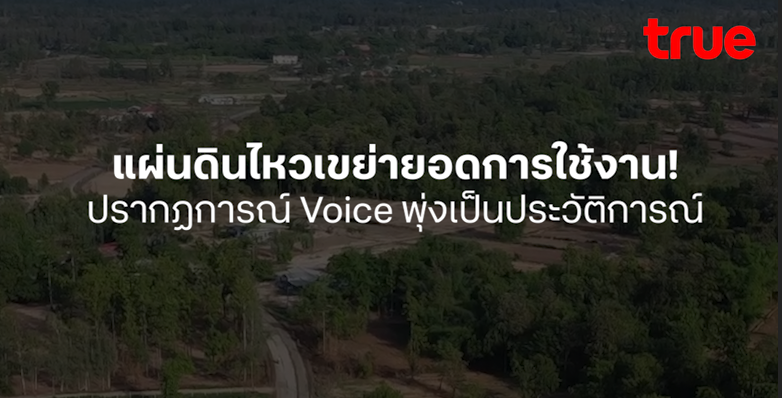On March 28, 2025, at approximately 1:25 PM, Thailand experienced tremors from an earthquake, which were felt across several areas in Bangkok and nearby provinces. Within less than five minutes, communication behavior on the True and dtac networks shifted dramatically. Outgoing voice calls surged by an average of more than five times, while data usage patterns also changed significantly.
Voice calls became the primary channel for urgent personal contact, while data usage was directed toward targeted communication through apps like LINE Messenger and X. Users relied on these platforms to send messages, respond to inquiries, and check news updates. This trend reflects the critical need for instant communication during emergency situations.
Network Usage Behavior During Emergencies
The data from True and dtac networks during the earthquake provides a clear picture of user behavior in emergency situations. This can be categorized into two main aspects:
Voice Usage
- Peak period: Between 1:30 – 1:45 PM, voice call volume on both True and dtac networks reached its highest levels.
True Network:
- Outgoing call volume surged by 465% compared to the same period on March 27, 2025 (from 1.57 million calls to 8.89 million calls).
- The peak occurred at 1:33 PM, with an increase of 299,000 calls, or 672% above the normal rate.
dtac Network:
- Outgoing call volume increased by 545% compared to the same period on March 27, 2025 (from 2.67 million calls to 17.23 million calls).
- The highest spike was at 1:32 PM, with an increase of 300,000 calls, or 1,061% above the normal rate.
- Calls within the same network increased by 65%, while cross-network calls surged by 121%.
- While call volume spiked sharply in the first hour, it gradually declined but remained above normal levels until midnight.
Outgoing Call Volume by Region During Peak Calling Period
True Network – Peak time: 1:33 PM. The increase in call volume by region (highest to lowest):
- Bangkok: +1,171%
- Western Region: +618%
- Southern Region: +455%
- Eastern Region: +426%
- Central Region: +285%
- Northern Region: +112%
- Upper Northeastern Region: +82%
dtac Network – Peak time: 1:32 PM. The increase in call volume by region (highest to lowest):
- Bangkok: +1,983%
- Western Region: +1,054%
- Central Region: +822%
- Northern Region: +541%
- Eastern Region: +269%
- Southern Region: +229%
- Upper Northeastern Region: +103%
Key Takeaway
The data suggests that in emergency situations, users tend to rely on voice calls as the primary communication channel. The significant surge in outgoing calls highlights the crucial role of voice communication in confirming personal safety and ensuring immediate contact between individuals.
Data Usage
- Noticeable changes in data usage were observed between 1:15 – 2:15 PM. During 1:15 – 1:30 PM, data usage on both True and dtac networks dropped, reflecting a temporary disruption due to the unexpected event.
- From 2:00 – 7:00 PM, data usage rose above normal levels and remained high.
- True data usage: +917 TB (9%)
- dtac data usage: +653 TB (13%)
Usage of 7 Popular Apps During the Earthquake
Analyzing the top 7 apps (Facebook, Messenger, Instagram, TikTok, YouTube, LINE, X) during 1:15 – 2:15 PM shows a common trend across True and dtac:
- Communication apps (X, LINE, Messenger) saw the highest increase in usage.
- Video apps (YouTube, TikTok) experienced a decline or minimal increase in usage.
This indicates that during emergencies, users prioritize real-time communication and situation updates.
True Network
- Total increase: 469,118 MB (+16%) and peak app usage: 4:33 PM
- X: +199%
- LINE: +74%
- Messenger: +41%
- Facebook: +35%
- YouTube: -7.8%
- TikTok: -0.9%
dtac Network
- Total increase: 290,063 MB (+17%) and peak app usage: 1:25 PM (immediately after the earthquake was felt.)
- X: +162%
- LINE: +90%
- Messenger: +77%
- Facebook: +33%
- YouTube: -6%
- TikTok: +0.6%
Key Takeaway
During emergencies, users shift towards communication-focused apps rather than consuming video content. Data usage becomes purpose-driven, enabling people to confirm safety, access real-time news, and stay connected during critical moments.
Behind the Scenes: Elevating Emergency Response Measures
In the wake of the recent earthquake, True Corporation’s network team promptly enhanced their emergency response protocols by establishing a “war room” at the Business and Network Intelligence Center (BNIC). This center utilizes artificial intelligence (AI) to oversee and manage network operations around the clock, ensuring continuous and efficient communication services for all users.









